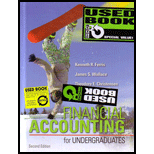
Compute the ratios of Company T for 2010 and 2011 and comment on the results.
Answer to Problem 11EYK
Computation of ratios of Company T for 2010 and 2011:
| Ratios and Formula |
2010 (in million £) |
2011 (in million £) |
|
a. | ||
|
b. Quick ratio: |
| |
|
c. Receivables turnover: Average accounts receivable: |
|
|
|
d. Inventory turnover: Average inventory: |
|
|
|
e. Debt to equity ratio: | ||
|
f. Number of times interest was earned: | ||
|
g. Return on sales: | ||
|
h. Return on assets: Average total assets: |
|
|
|
i. Return on common stockholders’ equity: |
Table (1)
Note: Quick assets include cash, short term investments and accounts receivable (net).
Analysis of trends:
- a. The current ratio of Company T has slightly decreased in the year 2011.
- b. The quick ratio of Company T has decreased drastically in the year 2011.
- c. The receivables turnover ratio of Company T has decreased from 30.69 times in 2010 to 29 times in 2011.
- d. The inventory turnover ratio of Company T has decreased from 19.38 times in 2010 to 18.97 times in 2011.
- e. The Debt equity ratio of Company T has declined in 2011(0.77) as compared in 2010 (1.04).
- f. The number of times interest earned ratio has increased drastically in 2011 (8.31) as compared in 2010 (6.49).
- g. The return on sales of Company T has slightly increased from 4.10% in 2010 to 4.38% in 2011.
- h. The return on assets of Company T has increased drastically from 5.10% in 2010 to 5.73% in 2011.
- i. The return on common stockholders’ equity of Company T has increased from 16.93% in 2010 to 17.06% in 2011.
Explanation of Solution
Financial Ratios: Financial ratios are the tools used to evaluate the liquidity, capabilities, profitability, and overall performance of a company.
- a. Current ratio: Current ratio is one of the
liquidity ratios , which measures the capacity of the company to meet its short-term obligations using its current assets. Current ratio is calculated by using the formula:
- b. Quick ratio: It is a ratio used to determine a company’s ability to pay back its current liabilities by liquid assets that are current assets except inventory and prepaid expenses.
- c. Receivables turnover ratio: Receivables turnover ratio is mainly used to evaluate the collection process efficiency. It helps the company to know the number of times the
accounts receivable is collected in a particular time period. This ratio is determined by dividing credit sales and sales return.
- d. Inventory Turnover Ratio: This ratio is a financial metric used by a company to quantify the number of times inventory is used or sold during the accounting period. It is calculated by using the formula:
- e. Debt–to-equity ratio: The debt-to-equity ratio indicates that the company’s debt as a proportion of its
stockholders’ equity . The debt-to-equity ratio is calculated using the formula:
- f. Number of times interest was earned: Number of times interest is earned quantifies the number of times the earnings before interest and taxes can pay the interest expense. First, determine the sum of income before income tax and interest expense. Then, divide the sum by interest expense.
- g. Return on sales: It is one of the profitability ratios. Profit margin ratio is used to measure the percentage of net income that is being generated per dollar of revenue or sales.
- h. Return on assets: Return on assets is the financial ratio which determines the amount of net income earned by the business with the use of total assets owned by it. It indicates the magnitude of the company’s earnings with relative to its total assets. Return on investment is calculated as follows:
- i. Return on common stockholders’ equity ratio: It is a profitability ratio that measures the profit generating ability of the company from the invested money of the shareholders. The formula to calculate the return on equity is as follows:
Working Note:
Determine the amount of earnings before interest and expenses for 2010.
Determine the amount of earnings before interest and expenses for Year 2011.
Determine the average common stockholders’ equity for Year 2010.
Determine the average common stockholders’ equity for Year 2011.
Want to see more full solutions like this?
Chapter 13 Solutions
Financial Accounting for Undergraduates

 AccountingAccountingISBN:9781337272094Author:WARREN, Carl S., Reeve, James M., Duchac, Jonathan E.Publisher:Cengage Learning,
AccountingAccountingISBN:9781337272094Author:WARREN, Carl S., Reeve, James M., Duchac, Jonathan E.Publisher:Cengage Learning, Accounting Information SystemsAccountingISBN:9781337619202Author:Hall, James A.Publisher:Cengage Learning,
Accounting Information SystemsAccountingISBN:9781337619202Author:Hall, James A.Publisher:Cengage Learning, Horngren's Cost Accounting: A Managerial Emphasis...AccountingISBN:9780134475585Author:Srikant M. Datar, Madhav V. RajanPublisher:PEARSON
Horngren's Cost Accounting: A Managerial Emphasis...AccountingISBN:9780134475585Author:Srikant M. Datar, Madhav V. RajanPublisher:PEARSON Intermediate AccountingAccountingISBN:9781259722660Author:J. David Spiceland, Mark W. Nelson, Wayne M ThomasPublisher:McGraw-Hill Education
Intermediate AccountingAccountingISBN:9781259722660Author:J. David Spiceland, Mark W. Nelson, Wayne M ThomasPublisher:McGraw-Hill Education Financial and Managerial AccountingAccountingISBN:9781259726705Author:John J Wild, Ken W. Shaw, Barbara Chiappetta Fundamental Accounting PrinciplesPublisher:McGraw-Hill Education
Financial and Managerial AccountingAccountingISBN:9781259726705Author:John J Wild, Ken W. Shaw, Barbara Chiappetta Fundamental Accounting PrinciplesPublisher:McGraw-Hill Education





